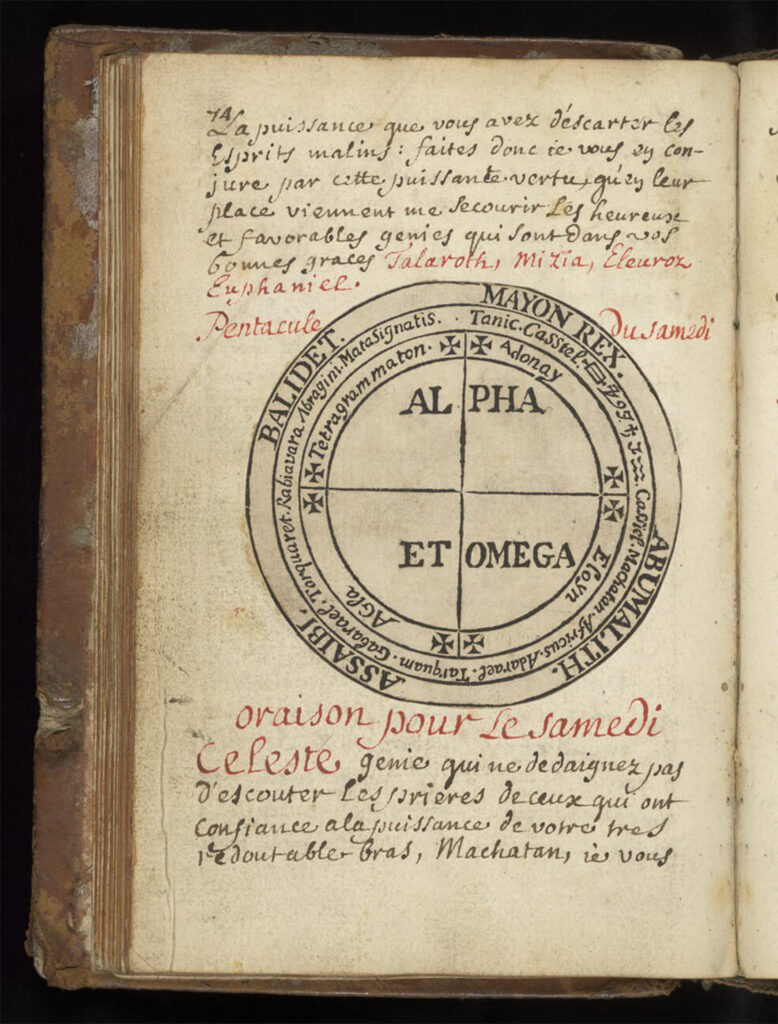pour faciliter l’intelligence de ce que Cornelius Agrippa … a escrit de plus curieux sur les mistères de la grande Cabale … Copié exactement sur le verritable original de la Bibliotèque du Duc de Mantoüe, traduit de l’hébreu.
Key of Solomon manuscript from the Clavicule Magique et Cabalistique Text-Group, 1725
The present manuscript, Clavicule de Salomon, ou la Clef mistérieuse de la Science cabalistique, is a Pseudo-Solomonic grimoire preserved at the Wellcome Library in London. It is one of the lesser know French variations of the Key of Solomon dated 1639 but written closer to 1725. Stephen Skinner classifies it in the ‘Clavicule Magique et Cabalistique’ family of texts. Its prologue states that it was translated from Hebrew into Latin by Henry Cornelius Agrippa, and subsequently into French from the Latin by Rabi Nazar. This is most likely a variation of Rabbi Abognazar who supposedly translated the Les Veritable Clavicles of Solomon text family (i.e. Lansdowne MS. 1203, BN MS 25314). In his Mysteries and Secrets of Magic, C.J.S, Thompson suggests that ‘Abognazar’ may have been a corruption of of Aben Ezra or Abraham Ben Meir ibn Ezra (1092-1167). The material is typically divided into 17 chapters although this particular manuscript specifies only 16 chapters.
Chapter four (p. 40-81) contains the protective floor circles for each of the Aerial kings from Peter de Abano’s Heptameron. However this text explains how to prepare them as talismans. This approach is consistent with the ‘Rabbi Solomon’ and ‘Abognazar’ family of Key of Solomon texts. Whoever created the manuscript decided against drawing each figure by hand and instead pasted printed versions of the figures into each page, potentially as a way to save time (see figure 1 below). To my knowledge however there wasn’t a book containing all seven circles at the time the manuscript was compiled. The Heptameron has been in print since 1559 but the book depicts the circle for Varcan Rex only. This begs the question, where did the scribe procure these images? If there is a edition of the Key of Solomon containing these figures printed before 1725, it has yet to be identified.
The final chapter contains a peculiar collection of five pentacles (p. 231-235), four of which were apparently inspired by Paracelsus’ treatise on elemental beings that correspond to the four classical elements: nymphs (water), sylphs (air), pygmies (earth) and salamanders (fire). The pentacles have been drawn around printed Key of Solomon pentacles that have been pasted into the manuscript from a printed copy of Le Petit Albert (see Figure 2 below). The components of each pentacle is interesting as well. Below is a table that explains how the correspond.
Table of Elemental Pentacles
| Pentacle | Being | Element | Direction | Spirits |
|---|---|---|---|---|
| Treasure | Gnomes | Earth | West | Guriel, Elyel, Barlechia, Madiniel |
| Success in the sciences | salamanders | Fire | East | Savania, Gedoria, Cocariel, Hoemadiel |
| Gambling | Sylphs | Air | South | Nagariel, Sodocciah, Buccoziel, Achelia |
| Success in the Liberal arts | nymphs | Water | North | Arbuphaz, Maziel, Oroniel, Paphah |
Composite Pentacles

Figure 1 
Figure 2
Catalog description: Title in red and black: illustrated by numerous pen-drawings in red or red and black of sigils and cabbalistic figures, etc. Stamped AD on the title-page, on the last leaf, and several times in the text.




